Organizational Behavior: Comparative Analysis of Three Articles
VerifiedAdded on 2021/06/17
|10
|2423
|64
Essay
AI Summary
This essay provides a comparative analysis of three scholarly articles focused on organizational behavior. The first article examines team dynamics in isolated, confined, and extreme environments, highlighting the impact of such settings on individual behavior and performance, and it is noted that behavioral changes do not necessarily lead to performance decrements. The second article delves into the impact of task conflict, differentiating between situations where conflict perceptions are skewed among team members, with positive outcomes associated with reflective communication. The third article explores intergroup relations and the use of structured group discussions to manage conflicts arising from differing perspectives, emphasizing the importance of cooperation in achieving team goals and reducing competition. The essay highlights similarities, such as the impact of human behavior on team performance, and differences in organizational settings and methodologies, and concludes with recommendations for organizations to leverage organizational behavior principles for improved team management, conflict resolution, and structured discussions to foster cooperation and commitment.
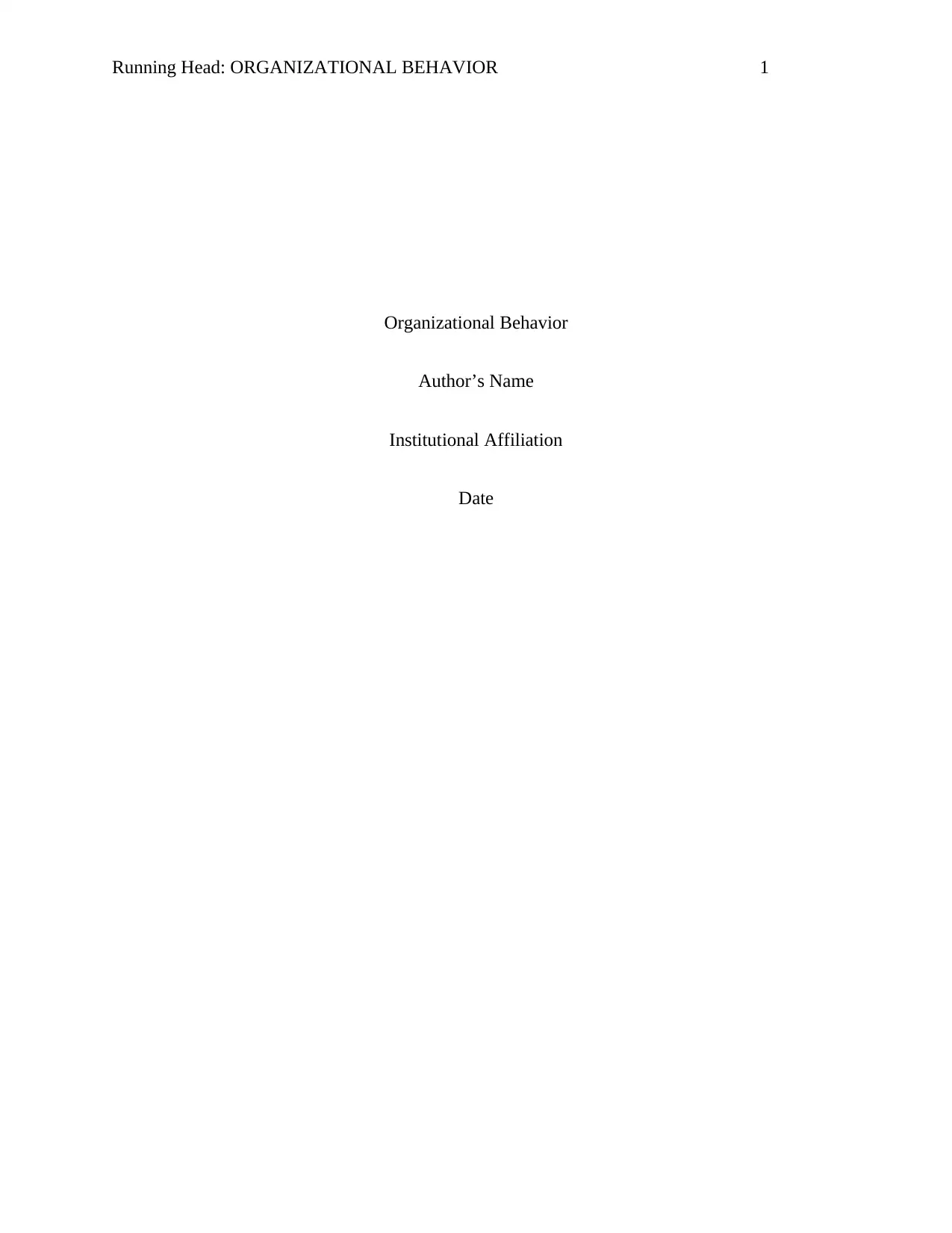
Running Head: ORGANIZATIONAL BEHAVIOR 1
Organizational Behavior
Author’s Name
Institutional Affiliation
Date
Organizational Behavior
Author’s Name
Institutional Affiliation
Date
Paraphrase This Document
Need a fresh take? Get an instant paraphrase of this document with our AI Paraphraser
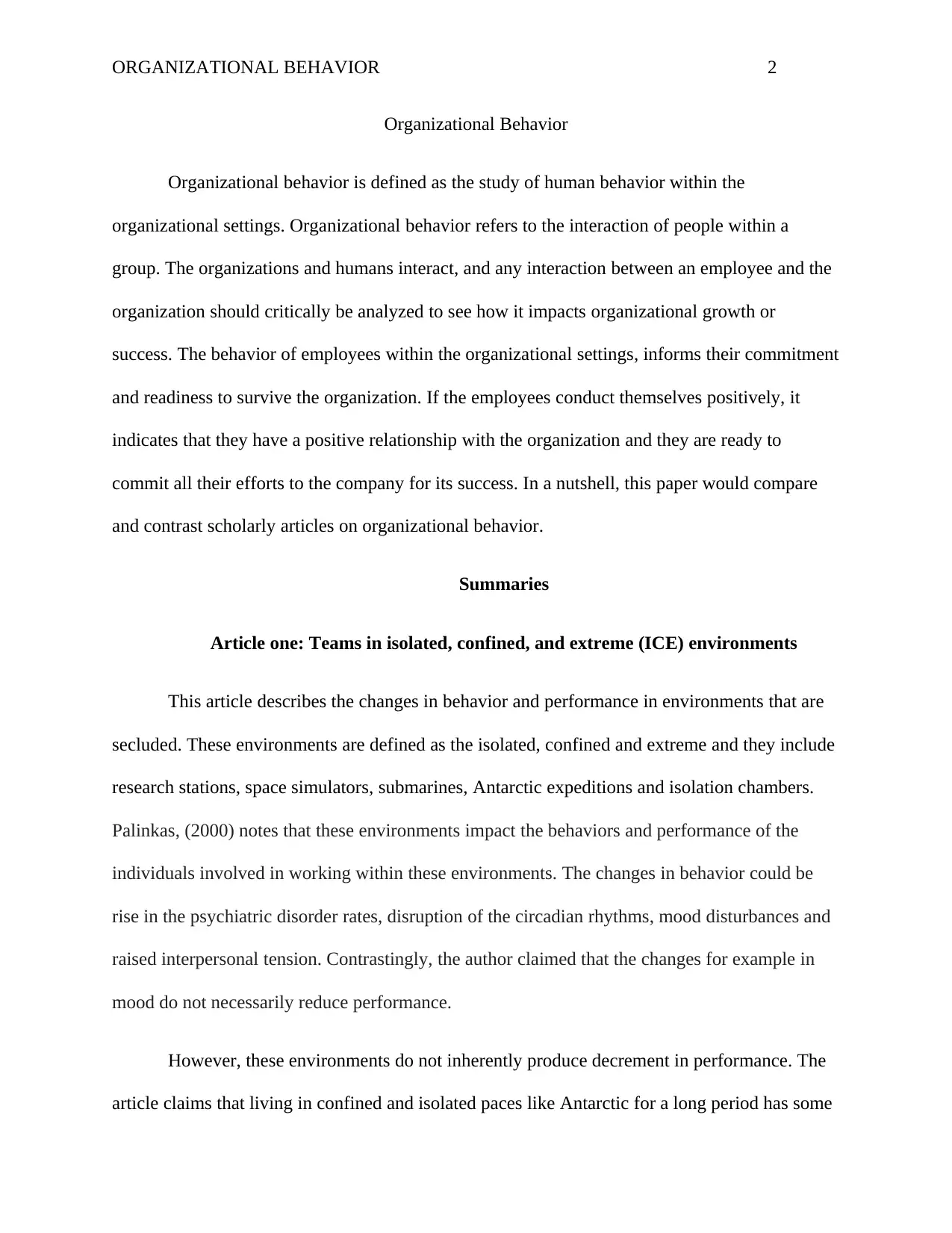
ORGANIZATIONAL BEHAVIOR 2
Organizational Behavior
Organizational behavior is defined as the study of human behavior within the
organizational settings. Organizational behavior refers to the interaction of people within a
group. The organizations and humans interact, and any interaction between an employee and the
organization should critically be analyzed to see how it impacts organizational growth or
success. The behavior of employees within the organizational settings, informs their commitment
and readiness to survive the organization. If the employees conduct themselves positively, it
indicates that they have a positive relationship with the organization and they are ready to
commit all their efforts to the company for its success. In a nutshell, this paper would compare
and contrast scholarly articles on organizational behavior.
Summaries
Article one: Teams in isolated, confined, and extreme (ICE) environments
This article describes the changes in behavior and performance in environments that are
secluded. These environments are defined as the isolated, confined and extreme and they include
research stations, space simulators, submarines, Antarctic expeditions and isolation chambers.
Palinkas, (2000) notes that these environments impact the behaviors and performance of the
individuals involved in working within these environments. The changes in behavior could be
rise in the psychiatric disorder rates, disruption of the circadian rhythms, mood disturbances and
raised interpersonal tension. Contrastingly, the author claimed that the changes for example in
mood do not necessarily reduce performance.
However, these environments do not inherently produce decrement in performance. The
article claims that living in confined and isolated paces like Antarctic for a long period has some
Organizational Behavior
Organizational behavior is defined as the study of human behavior within the
organizational settings. Organizational behavior refers to the interaction of people within a
group. The organizations and humans interact, and any interaction between an employee and the
organization should critically be analyzed to see how it impacts organizational growth or
success. The behavior of employees within the organizational settings, informs their commitment
and readiness to survive the organization. If the employees conduct themselves positively, it
indicates that they have a positive relationship with the organization and they are ready to
commit all their efforts to the company for its success. In a nutshell, this paper would compare
and contrast scholarly articles on organizational behavior.
Summaries
Article one: Teams in isolated, confined, and extreme (ICE) environments
This article describes the changes in behavior and performance in environments that are
secluded. These environments are defined as the isolated, confined and extreme and they include
research stations, space simulators, submarines, Antarctic expeditions and isolation chambers.
Palinkas, (2000) notes that these environments impact the behaviors and performance of the
individuals involved in working within these environments. The changes in behavior could be
rise in the psychiatric disorder rates, disruption of the circadian rhythms, mood disturbances and
raised interpersonal tension. Contrastingly, the author claimed that the changes for example in
mood do not necessarily reduce performance.
However, these environments do not inherently produce decrement in performance. The
article claims that living in confined and isolated paces like Antarctic for a long period has some
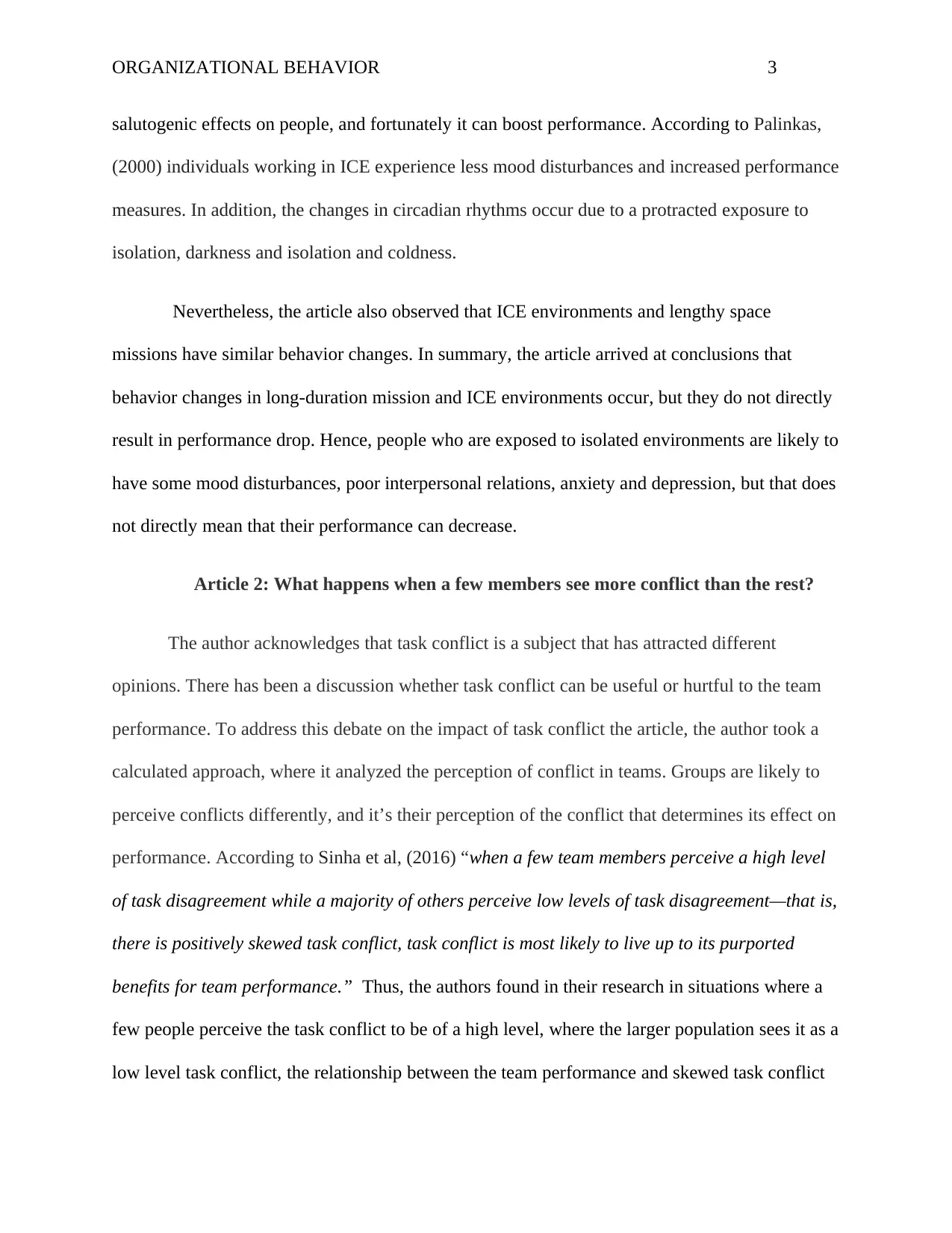
ORGANIZATIONAL BEHAVIOR 3
salutogenic effects on people, and fortunately it can boost performance. According to Palinkas,
(2000) individuals working in ICE experience less mood disturbances and increased performance
measures. In addition, the changes in circadian rhythms occur due to a protracted exposure to
isolation, darkness and isolation and coldness.
Nevertheless, the article also observed that ICE environments and lengthy space
missions have similar behavior changes. In summary, the article arrived at conclusions that
behavior changes in long-duration mission and ICE environments occur, but they do not directly
result in performance drop. Hence, people who are exposed to isolated environments are likely to
have some mood disturbances, poor interpersonal relations, anxiety and depression, but that does
not directly mean that their performance can decrease.
Article 2: What happens when a few members see more conflict than the rest?
The author acknowledges that task conflict is a subject that has attracted different
opinions. There has been a discussion whether task conflict can be useful or hurtful to the team
performance. To address this debate on the impact of task conflict the article, the author took a
calculated approach, where it analyzed the perception of conflict in teams. Groups are likely to
perceive conflicts differently, and it’s their perception of the conflict that determines its effect on
performance. According to Sinha et al, (2016) “when a few team members perceive a high level
of task disagreement while a majority of others perceive low levels of task disagreement—that is,
there is positively skewed task conflict, task conflict is most likely to live up to its purported
benefits for team performance.” Thus, the authors found in their research in situations where a
few people perceive the task conflict to be of a high level, where the larger population sees it as a
low level task conflict, the relationship between the team performance and skewed task conflict
salutogenic effects on people, and fortunately it can boost performance. According to Palinkas,
(2000) individuals working in ICE experience less mood disturbances and increased performance
measures. In addition, the changes in circadian rhythms occur due to a protracted exposure to
isolation, darkness and isolation and coldness.
Nevertheless, the article also observed that ICE environments and lengthy space
missions have similar behavior changes. In summary, the article arrived at conclusions that
behavior changes in long-duration mission and ICE environments occur, but they do not directly
result in performance drop. Hence, people who are exposed to isolated environments are likely to
have some mood disturbances, poor interpersonal relations, anxiety and depression, but that does
not directly mean that their performance can decrease.
Article 2: What happens when a few members see more conflict than the rest?
The author acknowledges that task conflict is a subject that has attracted different
opinions. There has been a discussion whether task conflict can be useful or hurtful to the team
performance. To address this debate on the impact of task conflict the article, the author took a
calculated approach, where it analyzed the perception of conflict in teams. Groups are likely to
perceive conflicts differently, and it’s their perception of the conflict that determines its effect on
performance. According to Sinha et al, (2016) “when a few team members perceive a high level
of task disagreement while a majority of others perceive low levels of task disagreement—that is,
there is positively skewed task conflict, task conflict is most likely to live up to its purported
benefits for team performance.” Thus, the authors found in their research in situations where a
few people perceive the task conflict to be of a high level, where the larger population sees it as a
low level task conflict, the relationship between the team performance and skewed task conflict
⊘ This is a preview!⊘
Do you want full access?
Subscribe today to unlock all pages.

Trusted by 1+ million students worldwide
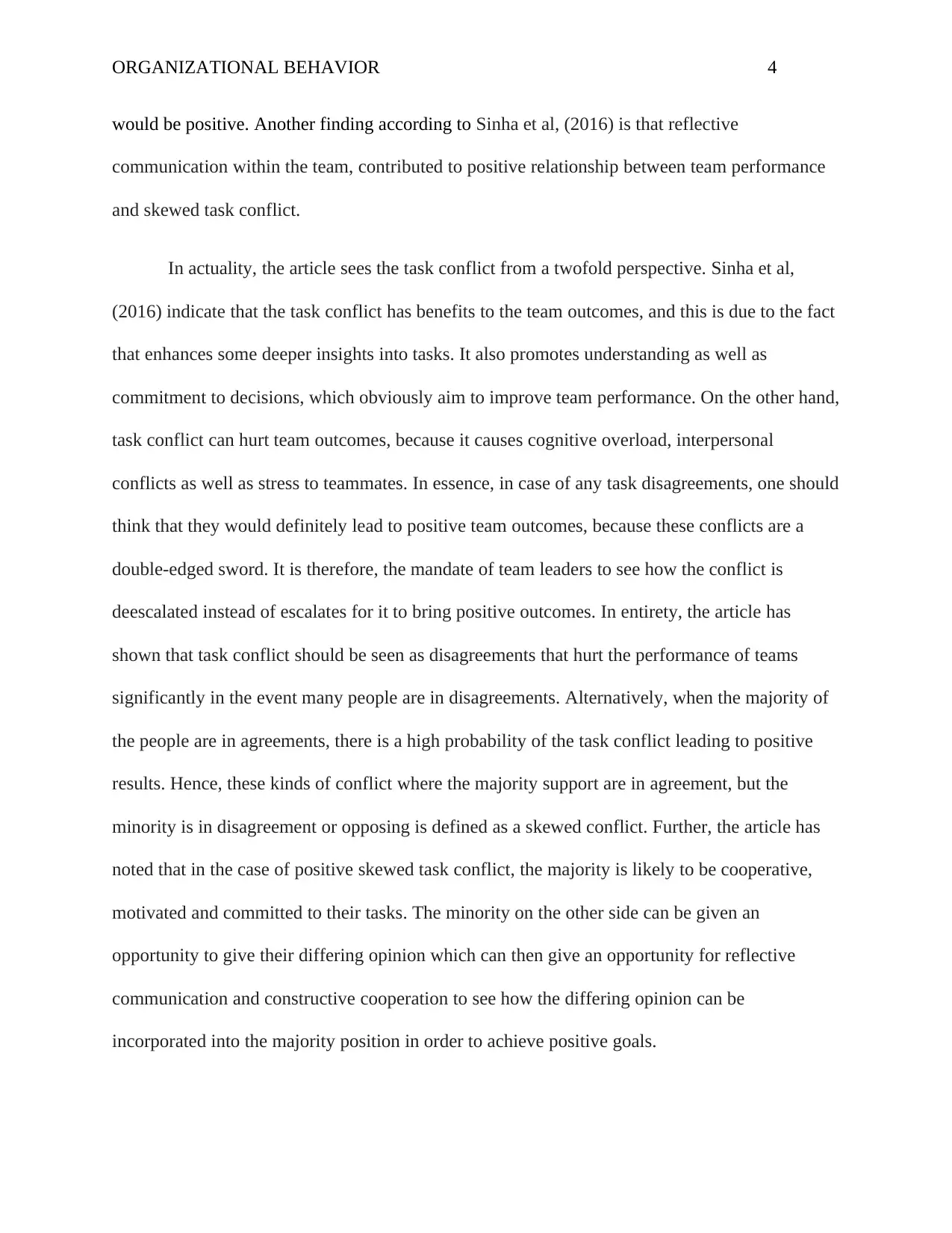
ORGANIZATIONAL BEHAVIOR 4
would be positive. Another finding according to Sinha et al, (2016) is that reflective
communication within the team, contributed to positive relationship between team performance
and skewed task conflict.
In actuality, the article sees the task conflict from a twofold perspective. Sinha et al,
(2016) indicate that the task conflict has benefits to the team outcomes, and this is due to the fact
that enhances some deeper insights into tasks. It also promotes understanding as well as
commitment to decisions, which obviously aim to improve team performance. On the other hand,
task conflict can hurt team outcomes, because it causes cognitive overload, interpersonal
conflicts as well as stress to teammates. In essence, in case of any task disagreements, one should
think that they would definitely lead to positive team outcomes, because these conflicts are a
double-edged sword. It is therefore, the mandate of team leaders to see how the conflict is
deescalated instead of escalates for it to bring positive outcomes. In entirety, the article has
shown that task conflict should be seen as disagreements that hurt the performance of teams
significantly in the event many people are in disagreements. Alternatively, when the majority of
the people are in agreements, there is a high probability of the task conflict leading to positive
results. Hence, these kinds of conflict where the majority support are in agreement, but the
minority is in disagreement or opposing is defined as a skewed conflict. Further, the article has
noted that in the case of positive skewed task conflict, the majority is likely to be cooperative,
motivated and committed to their tasks. The minority on the other side can be given an
opportunity to give their differing opinion which can then give an opportunity for reflective
communication and constructive cooperation to see how the differing opinion can be
incorporated into the majority position in order to achieve positive goals.
would be positive. Another finding according to Sinha et al, (2016) is that reflective
communication within the team, contributed to positive relationship between team performance
and skewed task conflict.
In actuality, the article sees the task conflict from a twofold perspective. Sinha et al,
(2016) indicate that the task conflict has benefits to the team outcomes, and this is due to the fact
that enhances some deeper insights into tasks. It also promotes understanding as well as
commitment to decisions, which obviously aim to improve team performance. On the other hand,
task conflict can hurt team outcomes, because it causes cognitive overload, interpersonal
conflicts as well as stress to teammates. In essence, in case of any task disagreements, one should
think that they would definitely lead to positive team outcomes, because these conflicts are a
double-edged sword. It is therefore, the mandate of team leaders to see how the conflict is
deescalated instead of escalates for it to bring positive outcomes. In entirety, the article has
shown that task conflict should be seen as disagreements that hurt the performance of teams
significantly in the event many people are in disagreements. Alternatively, when the majority of
the people are in agreements, there is a high probability of the task conflict leading to positive
results. Hence, these kinds of conflict where the majority support are in agreement, but the
minority is in disagreement or opposing is defined as a skewed conflict. Further, the article has
noted that in the case of positive skewed task conflict, the majority is likely to be cooperative,
motivated and committed to their tasks. The minority on the other side can be given an
opportunity to give their differing opinion which can then give an opportunity for reflective
communication and constructive cooperation to see how the differing opinion can be
incorporated into the majority position in order to achieve positive goals.
Paraphrase This Document
Need a fresh take? Get an instant paraphrase of this document with our AI Paraphraser
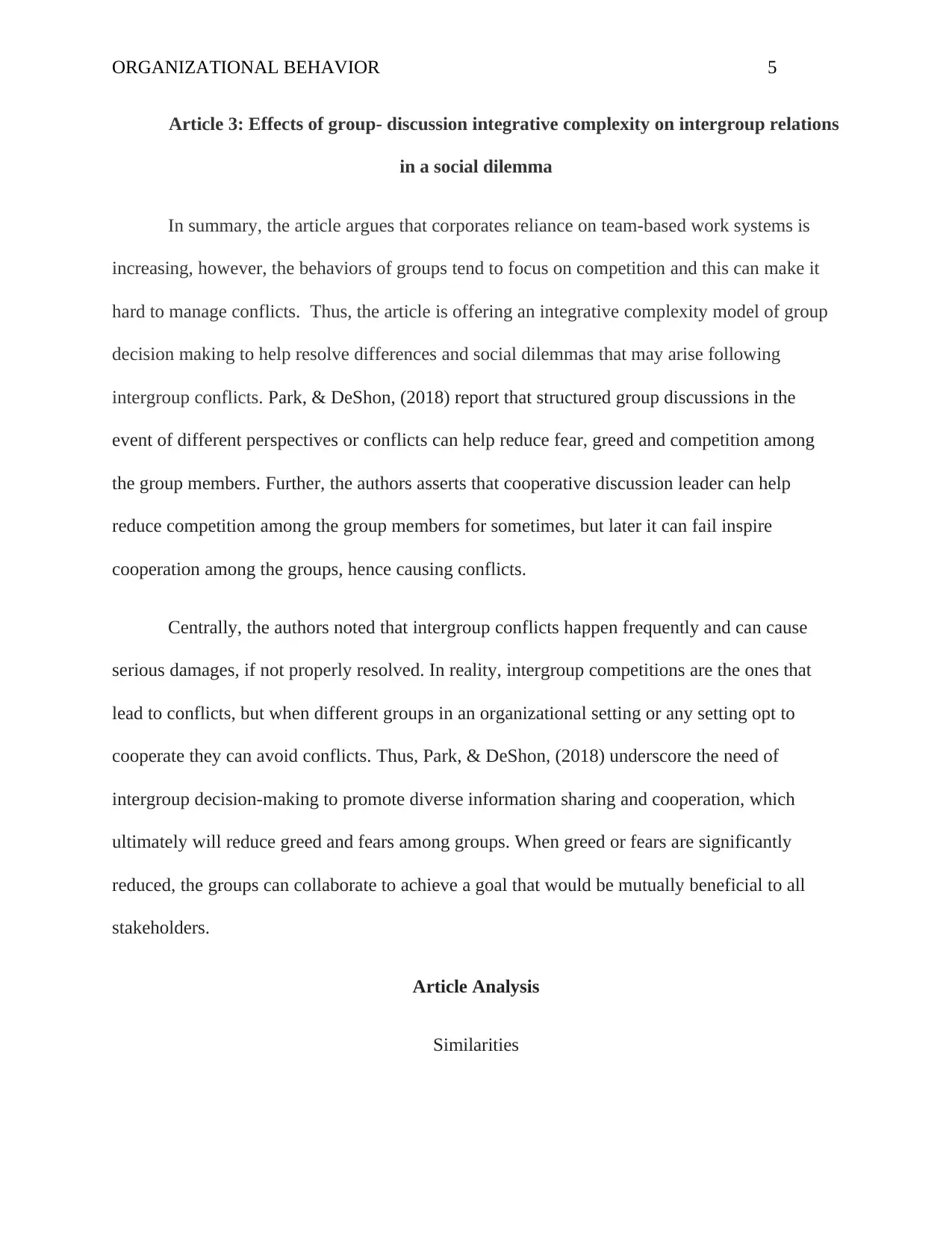
ORGANIZATIONAL BEHAVIOR 5
Article 3: Effects of group- discussion integrative complexity on intergroup relations
in a social dilemma
In summary, the article argues that corporates reliance on team-based work systems is
increasing, however, the behaviors of groups tend to focus on competition and this can make it
hard to manage conflicts. Thus, the article is offering an integrative complexity model of group
decision making to help resolve differences and social dilemmas that may arise following
intergroup conflicts. Park, & DeShon, (2018) report that structured group discussions in the
event of different perspectives or conflicts can help reduce fear, greed and competition among
the group members. Further, the authors asserts that cooperative discussion leader can help
reduce competition among the group members for sometimes, but later it can fail inspire
cooperation among the groups, hence causing conflicts.
Centrally, the authors noted that intergroup conflicts happen frequently and can cause
serious damages, if not properly resolved. In reality, intergroup competitions are the ones that
lead to conflicts, but when different groups in an organizational setting or any setting opt to
cooperate they can avoid conflicts. Thus, Park, & DeShon, (2018) underscore the need of
intergroup decision-making to promote diverse information sharing and cooperation, which
ultimately will reduce greed and fears among groups. When greed or fears are significantly
reduced, the groups can collaborate to achieve a goal that would be mutually beneficial to all
stakeholders.
Article Analysis
Similarities
Article 3: Effects of group- discussion integrative complexity on intergroup relations
in a social dilemma
In summary, the article argues that corporates reliance on team-based work systems is
increasing, however, the behaviors of groups tend to focus on competition and this can make it
hard to manage conflicts. Thus, the article is offering an integrative complexity model of group
decision making to help resolve differences and social dilemmas that may arise following
intergroup conflicts. Park, & DeShon, (2018) report that structured group discussions in the
event of different perspectives or conflicts can help reduce fear, greed and competition among
the group members. Further, the authors asserts that cooperative discussion leader can help
reduce competition among the group members for sometimes, but later it can fail inspire
cooperation among the groups, hence causing conflicts.
Centrally, the authors noted that intergroup conflicts happen frequently and can cause
serious damages, if not properly resolved. In reality, intergroup competitions are the ones that
lead to conflicts, but when different groups in an organizational setting or any setting opt to
cooperate they can avoid conflicts. Thus, Park, & DeShon, (2018) underscore the need of
intergroup decision-making to promote diverse information sharing and cooperation, which
ultimately will reduce greed and fears among groups. When greed or fears are significantly
reduced, the groups can collaborate to achieve a goal that would be mutually beneficial to all
stakeholders.
Article Analysis
Similarities
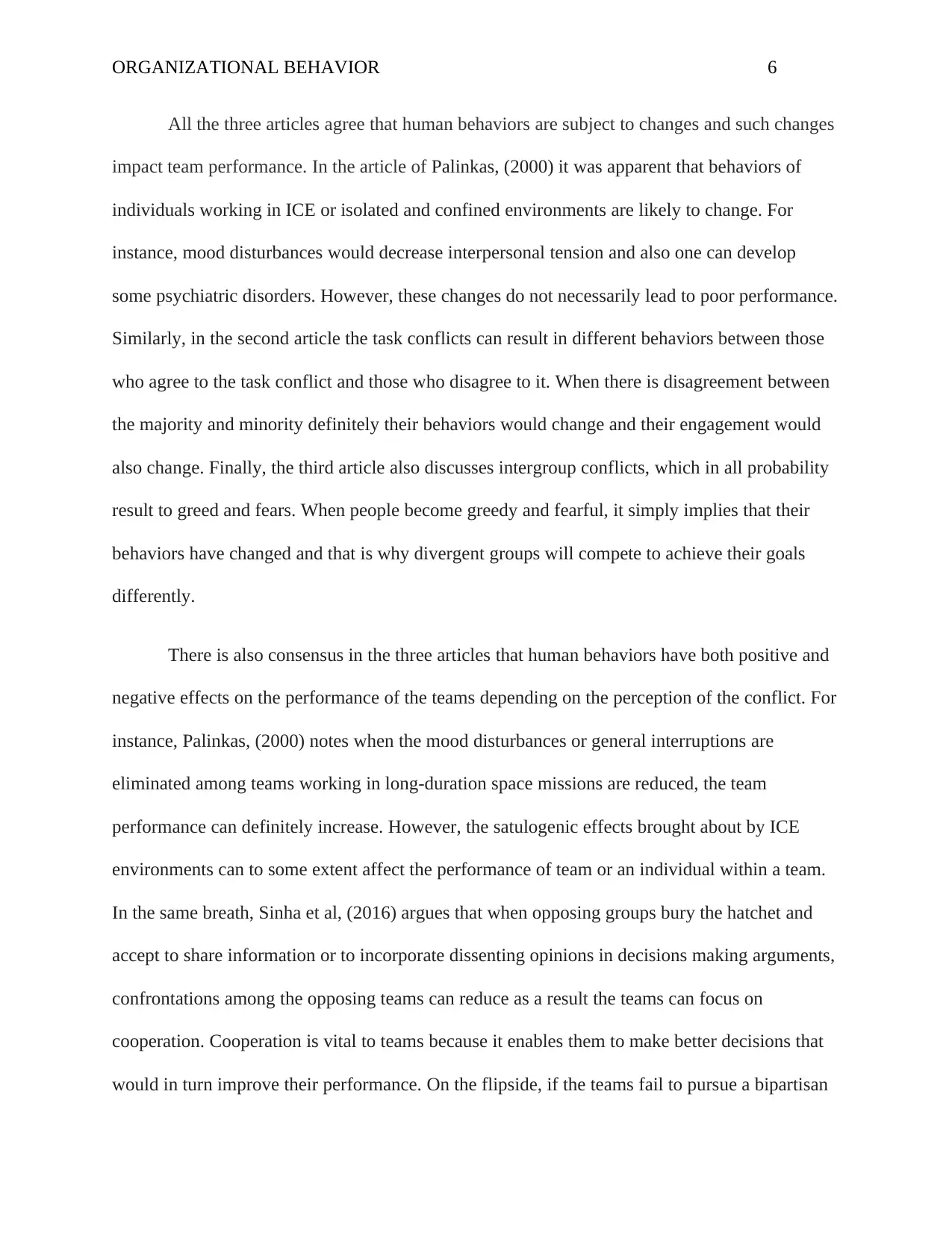
ORGANIZATIONAL BEHAVIOR 6
All the three articles agree that human behaviors are subject to changes and such changes
impact team performance. In the article of Palinkas, (2000) it was apparent that behaviors of
individuals working in ICE or isolated and confined environments are likely to change. For
instance, mood disturbances would decrease interpersonal tension and also one can develop
some psychiatric disorders. However, these changes do not necessarily lead to poor performance.
Similarly, in the second article the task conflicts can result in different behaviors between those
who agree to the task conflict and those who disagree to it. When there is disagreement between
the majority and minority definitely their behaviors would change and their engagement would
also change. Finally, the third article also discusses intergroup conflicts, which in all probability
result to greed and fears. When people become greedy and fearful, it simply implies that their
behaviors have changed and that is why divergent groups will compete to achieve their goals
differently.
There is also consensus in the three articles that human behaviors have both positive and
negative effects on the performance of the teams depending on the perception of the conflict. For
instance, Palinkas, (2000) notes when the mood disturbances or general interruptions are
eliminated among teams working in long-duration space missions are reduced, the team
performance can definitely increase. However, the satulogenic effects brought about by ICE
environments can to some extent affect the performance of team or an individual within a team.
In the same breath, Sinha et al, (2016) argues that when opposing groups bury the hatchet and
accept to share information or to incorporate dissenting opinions in decisions making arguments,
confrontations among the opposing teams can reduce as a result the teams can focus on
cooperation. Cooperation is vital to teams because it enables them to make better decisions that
would in turn improve their performance. On the flipside, if the teams fail to pursue a bipartisan
All the three articles agree that human behaviors are subject to changes and such changes
impact team performance. In the article of Palinkas, (2000) it was apparent that behaviors of
individuals working in ICE or isolated and confined environments are likely to change. For
instance, mood disturbances would decrease interpersonal tension and also one can develop
some psychiatric disorders. However, these changes do not necessarily lead to poor performance.
Similarly, in the second article the task conflicts can result in different behaviors between those
who agree to the task conflict and those who disagree to it. When there is disagreement between
the majority and minority definitely their behaviors would change and their engagement would
also change. Finally, the third article also discusses intergroup conflicts, which in all probability
result to greed and fears. When people become greedy and fearful, it simply implies that their
behaviors have changed and that is why divergent groups will compete to achieve their goals
differently.
There is also consensus in the three articles that human behaviors have both positive and
negative effects on the performance of the teams depending on the perception of the conflict. For
instance, Palinkas, (2000) notes when the mood disturbances or general interruptions are
eliminated among teams working in long-duration space missions are reduced, the team
performance can definitely increase. However, the satulogenic effects brought about by ICE
environments can to some extent affect the performance of team or an individual within a team.
In the same breath, Sinha et al, (2016) argues that when opposing groups bury the hatchet and
accept to share information or to incorporate dissenting opinions in decisions making arguments,
confrontations among the opposing teams can reduce as a result the teams can focus on
cooperation. Cooperation is vital to teams because it enables them to make better decisions that
would in turn improve their performance. On the flipside, if the teams fail to pursue a bipartisan
⊘ This is a preview!⊘
Do you want full access?
Subscribe today to unlock all pages.

Trusted by 1+ million students worldwide
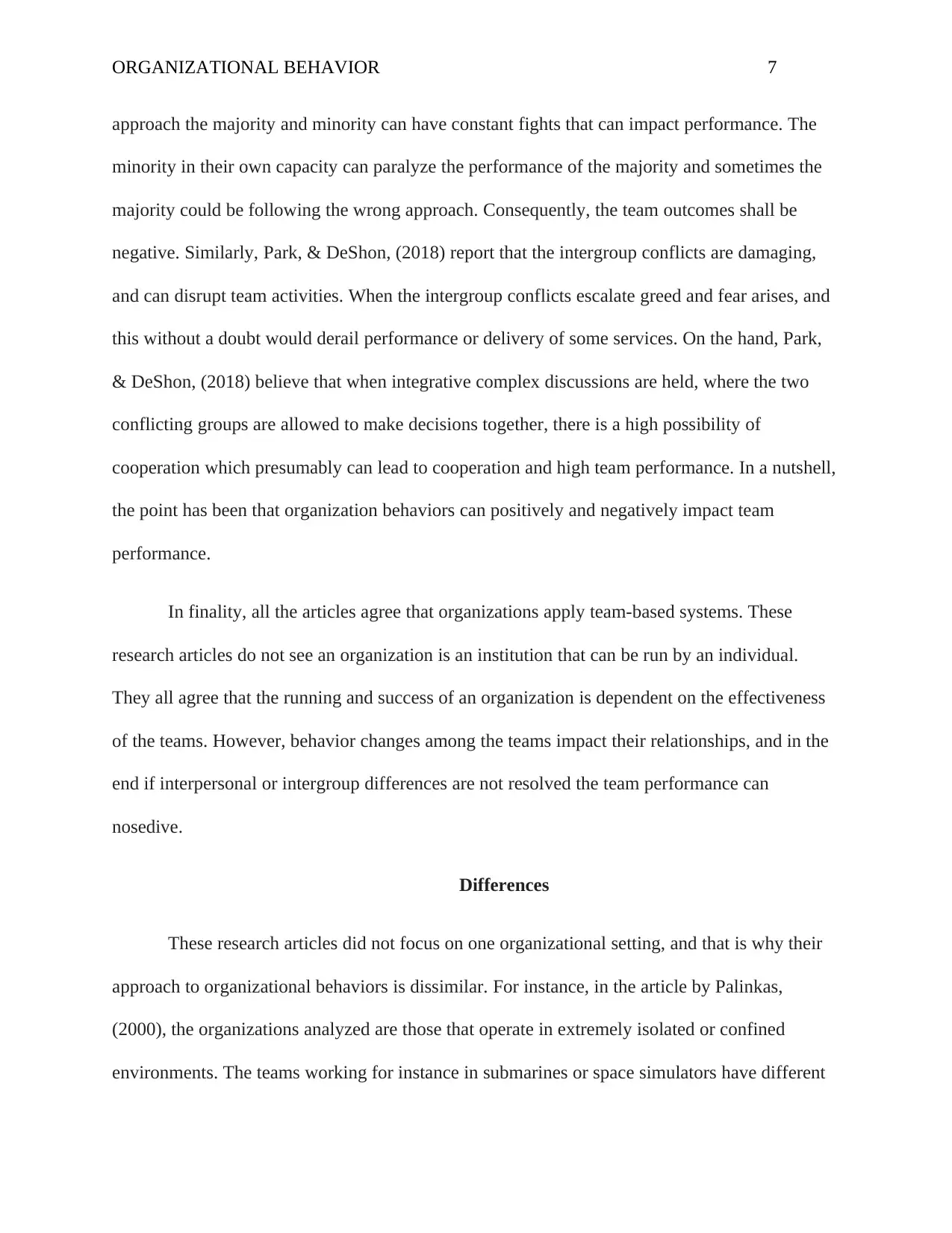
ORGANIZATIONAL BEHAVIOR 7
approach the majority and minority can have constant fights that can impact performance. The
minority in their own capacity can paralyze the performance of the majority and sometimes the
majority could be following the wrong approach. Consequently, the team outcomes shall be
negative. Similarly, Park, & DeShon, (2018) report that the intergroup conflicts are damaging,
and can disrupt team activities. When the intergroup conflicts escalate greed and fear arises, and
this without a doubt would derail performance or delivery of some services. On the hand, Park,
& DeShon, (2018) believe that when integrative complex discussions are held, where the two
conflicting groups are allowed to make decisions together, there is a high possibility of
cooperation which presumably can lead to cooperation and high team performance. In a nutshell,
the point has been that organization behaviors can positively and negatively impact team
performance.
In finality, all the articles agree that organizations apply team-based systems. These
research articles do not see an organization is an institution that can be run by an individual.
They all agree that the running and success of an organization is dependent on the effectiveness
of the teams. However, behavior changes among the teams impact their relationships, and in the
end if interpersonal or intergroup differences are not resolved the team performance can
nosedive.
Differences
These research articles did not focus on one organizational setting, and that is why their
approach to organizational behaviors is dissimilar. For instance, in the article by Palinkas,
(2000), the organizations analyzed are those that operate in extremely isolated or confined
environments. The teams working for instance in submarines or space simulators have different
approach the majority and minority can have constant fights that can impact performance. The
minority in their own capacity can paralyze the performance of the majority and sometimes the
majority could be following the wrong approach. Consequently, the team outcomes shall be
negative. Similarly, Park, & DeShon, (2018) report that the intergroup conflicts are damaging,
and can disrupt team activities. When the intergroup conflicts escalate greed and fear arises, and
this without a doubt would derail performance or delivery of some services. On the hand, Park,
& DeShon, (2018) believe that when integrative complex discussions are held, where the two
conflicting groups are allowed to make decisions together, there is a high possibility of
cooperation which presumably can lead to cooperation and high team performance. In a nutshell,
the point has been that organization behaviors can positively and negatively impact team
performance.
In finality, all the articles agree that organizations apply team-based systems. These
research articles do not see an organization is an institution that can be run by an individual.
They all agree that the running and success of an organization is dependent on the effectiveness
of the teams. However, behavior changes among the teams impact their relationships, and in the
end if interpersonal or intergroup differences are not resolved the team performance can
nosedive.
Differences
These research articles did not focus on one organizational setting, and that is why their
approach to organizational behaviors is dissimilar. For instance, in the article by Palinkas,
(2000), the organizations analyzed are those that operate in extremely isolated or confined
environments. The teams working for instance in submarines or space simulators have different
Paraphrase This Document
Need a fresh take? Get an instant paraphrase of this document with our AI Paraphraser
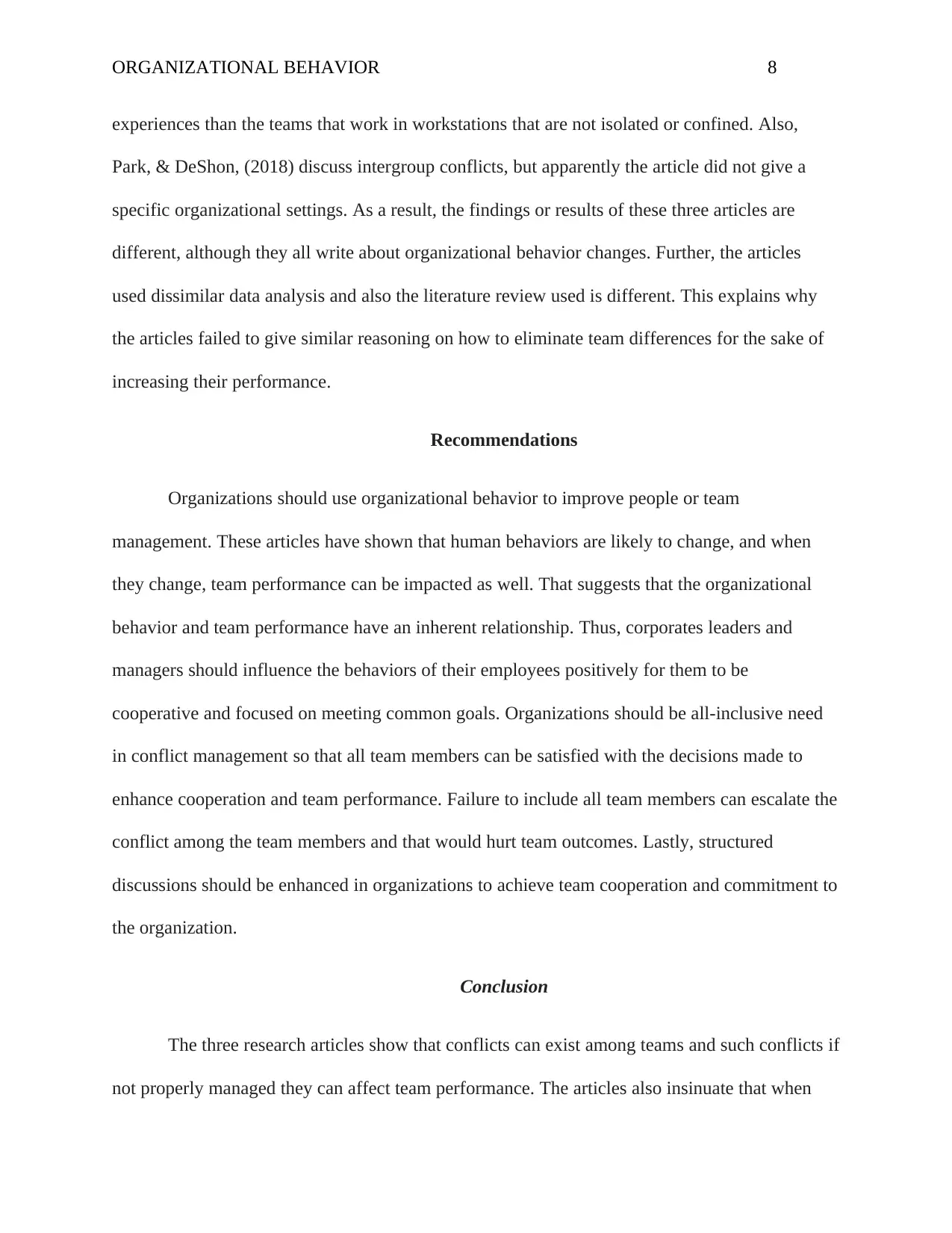
ORGANIZATIONAL BEHAVIOR 8
experiences than the teams that work in workstations that are not isolated or confined. Also,
Park, & DeShon, (2018) discuss intergroup conflicts, but apparently the article did not give a
specific organizational settings. As a result, the findings or results of these three articles are
different, although they all write about organizational behavior changes. Further, the articles
used dissimilar data analysis and also the literature review used is different. This explains why
the articles failed to give similar reasoning on how to eliminate team differences for the sake of
increasing their performance.
Recommendations
Organizations should use organizational behavior to improve people or team
management. These articles have shown that human behaviors are likely to change, and when
they change, team performance can be impacted as well. That suggests that the organizational
behavior and team performance have an inherent relationship. Thus, corporates leaders and
managers should influence the behaviors of their employees positively for them to be
cooperative and focused on meeting common goals. Organizations should be all-inclusive need
in conflict management so that all team members can be satisfied with the decisions made to
enhance cooperation and team performance. Failure to include all team members can escalate the
conflict among the team members and that would hurt team outcomes. Lastly, structured
discussions should be enhanced in organizations to achieve team cooperation and commitment to
the organization.
Conclusion
The three research articles show that conflicts can exist among teams and such conflicts if
not properly managed they can affect team performance. The articles also insinuate that when
experiences than the teams that work in workstations that are not isolated or confined. Also,
Park, & DeShon, (2018) discuss intergroup conflicts, but apparently the article did not give a
specific organizational settings. As a result, the findings or results of these three articles are
different, although they all write about organizational behavior changes. Further, the articles
used dissimilar data analysis and also the literature review used is different. This explains why
the articles failed to give similar reasoning on how to eliminate team differences for the sake of
increasing their performance.
Recommendations
Organizations should use organizational behavior to improve people or team
management. These articles have shown that human behaviors are likely to change, and when
they change, team performance can be impacted as well. That suggests that the organizational
behavior and team performance have an inherent relationship. Thus, corporates leaders and
managers should influence the behaviors of their employees positively for them to be
cooperative and focused on meeting common goals. Organizations should be all-inclusive need
in conflict management so that all team members can be satisfied with the decisions made to
enhance cooperation and team performance. Failure to include all team members can escalate the
conflict among the team members and that would hurt team outcomes. Lastly, structured
discussions should be enhanced in organizations to achieve team cooperation and commitment to
the organization.
Conclusion
The three research articles show that conflicts can exist among teams and such conflicts if
not properly managed they can affect team performance. The articles also insinuate that when
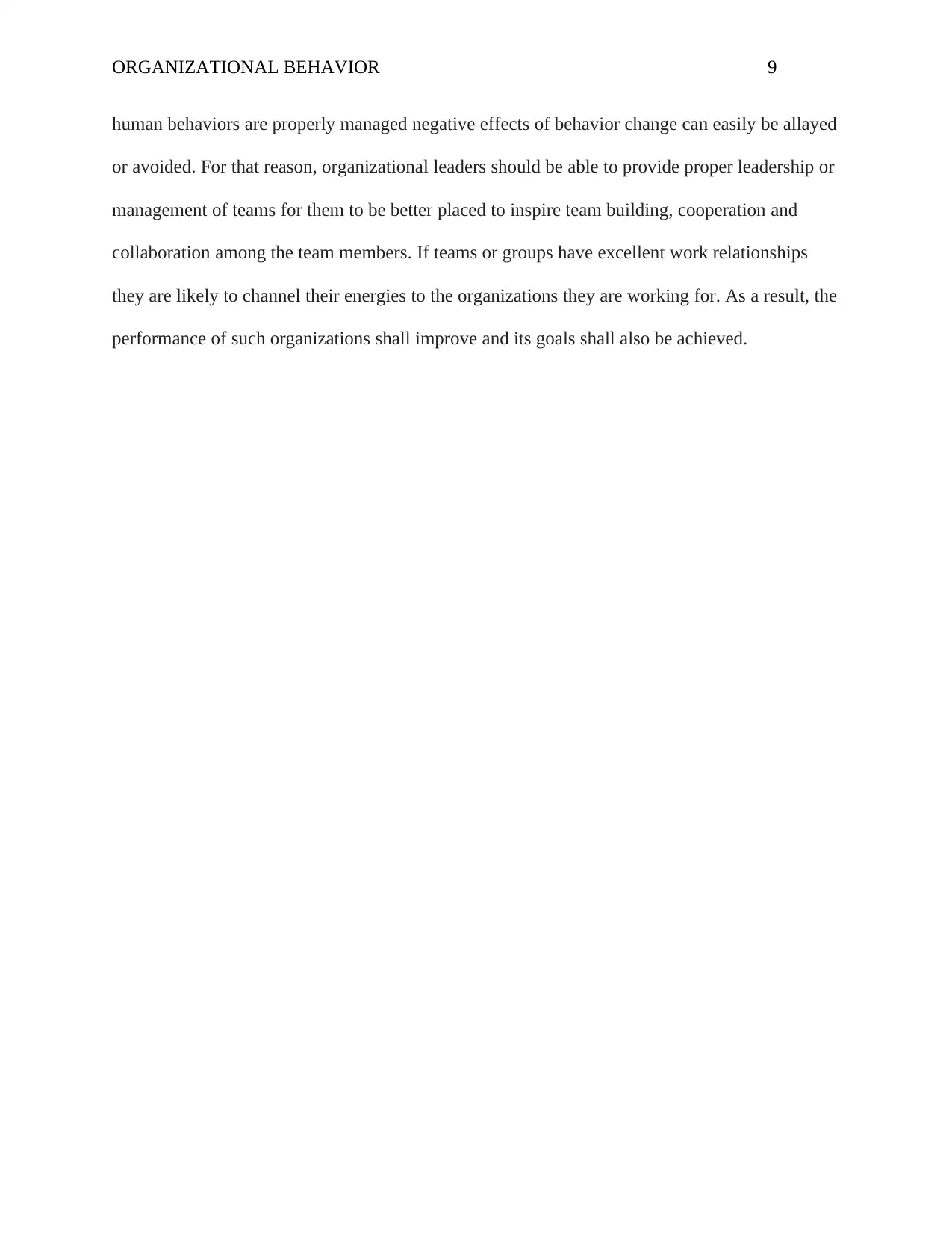
ORGANIZATIONAL BEHAVIOR 9
human behaviors are properly managed negative effects of behavior change can easily be allayed
or avoided. For that reason, organizational leaders should be able to provide proper leadership or
management of teams for them to be better placed to inspire team building, cooperation and
collaboration among the team members. If teams or groups have excellent work relationships
they are likely to channel their energies to the organizations they are working for. As a result, the
performance of such organizations shall improve and its goals shall also be achieved.
human behaviors are properly managed negative effects of behavior change can easily be allayed
or avoided. For that reason, organizational leaders should be able to provide proper leadership or
management of teams for them to be better placed to inspire team building, cooperation and
collaboration among the team members. If teams or groups have excellent work relationships
they are likely to channel their energies to the organizations they are working for. As a result, the
performance of such organizations shall improve and its goals shall also be achieved.
⊘ This is a preview!⊘
Do you want full access?
Subscribe today to unlock all pages.

Trusted by 1+ million students worldwide
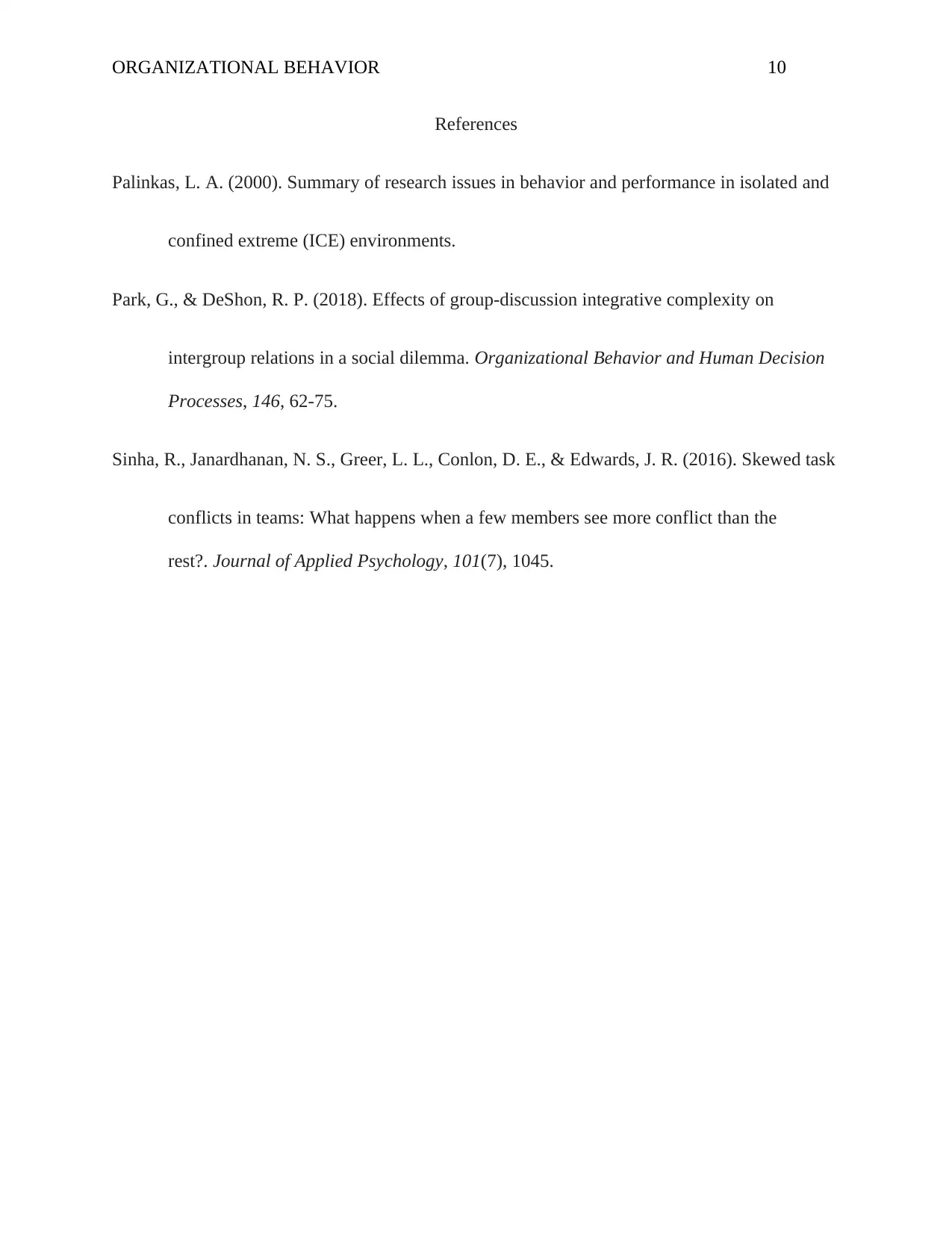
ORGANIZATIONAL BEHAVIOR 10
References
Palinkas, L. A. (2000). Summary of research issues in behavior and performance in isolated and
confined extreme (ICE) environments.
Park, G., & DeShon, R. P. (2018). Effects of group-discussion integrative complexity on
intergroup relations in a social dilemma. Organizational Behavior and Human Decision
Processes, 146, 62-75.
Sinha, R., Janardhanan, N. S., Greer, L. L., Conlon, D. E., & Edwards, J. R. (2016). Skewed task
conflicts in teams: What happens when a few members see more conflict than the
rest?. Journal of Applied Psychology, 101(7), 1045.
References
Palinkas, L. A. (2000). Summary of research issues in behavior and performance in isolated and
confined extreme (ICE) environments.
Park, G., & DeShon, R. P. (2018). Effects of group-discussion integrative complexity on
intergroup relations in a social dilemma. Organizational Behavior and Human Decision
Processes, 146, 62-75.
Sinha, R., Janardhanan, N. S., Greer, L. L., Conlon, D. E., & Edwards, J. R. (2016). Skewed task
conflicts in teams: What happens when a few members see more conflict than the
rest?. Journal of Applied Psychology, 101(7), 1045.
1 out of 10
Your All-in-One AI-Powered Toolkit for Academic Success.
+13062052269
info@desklib.com
Available 24*7 on WhatsApp / Email
![[object Object]](/_next/static/media/star-bottom.7253800d.svg)
Unlock your academic potential
Copyright © 2020–2025 A2Z Services. All Rights Reserved. Developed and managed by ZUCOL.